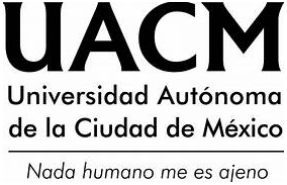O wn thinking and transdisciplinary integration in the social epistemic
DOI:
https://doi.org/10.29092/uacm.v13i31.428Keywords:
Own thinking, Transdisciplinary integration, Social epistemic, Social construction of knowledgeAbstract
Education evolves in a student’s life (ontogeny) and in the life of the school system (phylogeny). These routes can consolidate the continuity or a change for the formation of own thinking as a teaching strategy. The experience I present happened during the 2015-1 and 2016-1 terms of the study in Social Studies and Local Management at Unit ENES,UNAM Morelia in regard to the teaching of the subject Epistemology Research. I have based educational practice in collaboration dynamics, seeking to root cognitive training of one’s own thinking in young apprentices of social studies. The constant discovery, recovery of thinking in the present tense and mutual recognition produced synthetic results shown here for reflective unveiling.
Downloads
References
Alaminos, A. (2006), El análisis de la realidad social. Modelos estructurales de covarianzas, Alicante: Observatorio Europeo de Tendencias Sociales (Obets).
Berger, P. y Luckmann, T. (2001), La construcción social de la realidad, Buenos Aires: Amorrortu.
Bourdieu, P. (2012), Homo Academicus, Buenos Aires: Siglo xxi.
Campos, L. (2010), “Neuroeducación: uniendo las neurociencias y la educación en la búsqueda del desarrollo humano”. Artículo disponible en [http://www.educoea.org/portal/La_Educacion_ Digital/laeducacion_143/articles/neuroeducacion.pdf], 3 de diciembre de 2015.
Brentano, F. (1951), Aristóteles, Madrid: Labor.
Damasio, A. (2009), En busca de Spinoza. Neurobiología de los sentimientos y las emociones, Madrid: Crítica.
Dennett, D. (2000), Tipos de mentes. Hacia una comprensión de la conciencia. Madrid: Debate.
Descartes, R. (2010), Discurso del método, Madrid: Espasa-Calpe.
Descartes, R. (2011), Reglas para la dirección del espíritu y otras obras, Madrid: Gredos.
Foucault, M. (1997), Las palabras y las cosas. Una arqueología de las ciencias humanas, Buenos Aires: Siglo xxi.
Freire, P. (2004), Pedagogía de la autonomía: saberes necesarios para la práctica educativa, São Paulo: Paz e Terra.
García, R. (2006), Sistemas complejos. Conceptos, método y fundamentación epistemológica de la investigación interdisciplinaria, Barcelona: Gedisa.
Gergen, K. (2007), Construccionismo social. Aportes para el debate y la práctica, Bogotá: Universidad de los Andes (Uniandes).
Gros, B. (2005), “El aprendizaje colaborativo a través de la red: límites y posibilidades”. Artículo disponible en [http://www.uninorte.edu.co/congresog10/conf/08_El_Aprendizaje_Colaborativo_a_traves_de_la_red.pdf], 18 de marzo de 2015.
Instituto Tecnológico y de Estudios Superiores de Monterrey (ITESM) (s.a.), “Las estrategias y técnicas didácticas en el rediseño”. Dirección de Investigación y Desarrollo Educativo. Vicerrectoría Académica. Artículo disponible en [http://www.sistema.itesm.mx/va/dide/inf-doc/estrategias/colaborativo.html], 18 de marzo de 2015.
Kuhn. T. (2004), La estructura de las revoluciones científicas, México: Fondo de Cultura Económica (FCE).
Kant, I. (1998), Crítica de la razón pura, España: Alfaguara.
Levinas, E. (2002), Fuera del sujeto, Madrid: Caparrós.
Lucero, M. (2003), “Entre el trabajo colaborativo y el aprendizaje colaborativo.
Revista Iberoamericana de Educación”. Artículo disponible en [http://rieoei.org/deloslectores/528Lucero.PDF], 18 de marzo de 2015.
Luria, A. (1984), Conciencia y lenguaje, Madrid: Visor libros.
Manes, F. (s.a.), “¿Qué puede aportar la investigación en Neurociencias a la Educación?”, Revista Neurociencias y Educación. Artículo disponible en [http://live.v1.udesa.edu.ar/files/programas/NEUROCIENCIAS/Que_puede_aportar_la_investigacion_en_neurociencias_a_la_educaci%F3n_Manes.pdf], 3 de diciembre de 2015.
Merleau-Ponty, M. (1964), Signos, Barcelona: Seix Barral.
Moreno, J. (2004), “Entrevista a Basarab Nicolescu”. Entrevista disponible en [http://www.microrevista.com/entrevista-a-basarab-nicolescu/], 3 de diciembre de 2015.
Morin, E. (1999), El método. III: El conocimiento del conocimiento, Madrid: Cátedra.
Nicolescu, B. (s.a.), La transdisciplina. Manifiesto, Mónaco: Du Rocher.
Piaget, J. (1969), Psicología y pedagogía, Barcelona: Ariel.
Piaget, J. (1972), Psicología de la inteligencia, Buenos Aires: Psique.
Rodríguez, A. (2013), “Vivir y realidar”, en III Congreso Internacional sobre Arte y Sociedad. Universidad de Málaga. EUMED.net
Rodríguez, A. (2015), “Reciprocidad: tercero incluido del modelo transdisciplinario a posteriori en EA”, en V Congreso Internacional de Educación Ambiental para el Desarrollo, desde la Innovación, la Transdisciplinariedad e Interculturalidad, Xalapa: Universidad Veracruzana, 28-30 de septiembre.
Rodríguez, A. (2016), “Aproximación al Modelo del Campo Semántico de la Integración. Discursiva transdisciplinaria y compleja” (en prensa).
Sartre, J. (1996), Verdad y existencia. Barcelona: Paidós.
Saussure, F. (1945), Curso de lingüística general, Buenos Aires: Losada.
Searle, J. (1983), Intencionalidad. Un ensayo en la filosofía de la mente, Madrid: Tecnos.
Searle, J. (1997), La construcción de la realidad social, Barcelona: Paidós.
Varela, F. (2006), Conocer. Las ciencias cognitivas: tendencias y perspectivas. Cartografía de las ideas actuales, Barcelona: Gedisa.
Vigotsky, L. (2007), “Aprendizaje y desarrollo intelectual en la edad escolar”, en A. Luria, , A. Leontiev y L. Vigotsky (2007), Psicología y pedagogía, Madrid: Akal, pp. 23-40.
Wallerstein, I. (2000), “From Sociology to Historical Science: Prospects and Obstacles”, en British Journal of Sociology, vol. 51, núm. 1, enero-marzo, Londres: London School of Economics and Political Science (LSE), pp. 25-35.
Wallerstein, I. (2007), Abrir las ciencias sociales, México: Siglo xxi.
Published
Issue
Section
License
This Journal is licensed under Creative Commons Mexico 2.5. It is allowed to reproduce and disseminate the contents of the Journal for educational or research purposes, not for profit, as long as they are not mutilated and cite the source (Andamios, Revista de Investigación Social) and the author.
The copyright of the articles published in Andamios, Revista de Investigación Social are transferred by the author(s) to Universidad Autónoma de la Ciudad de México when the originals have been accepted, so that they are published and distributed both in the printed and electronic versions of the Journal. However, as established by law, the author(s) retains their moral rights. The author(s) will receive a form of assignment of copyright that they must to sign when their original has been accepted. In the case of collective articles, the signature of one of the authors will suffice, provided that the latter has obtained the consent of the others.
Authors may use the material of their article in other works or books published by themselves, with the condition of quoting Andamios as the original source of the texts.
The articles contained in this publication are the responsibility of their authors and do not compromise the official position of Andamios, Revista de Investigación Social of the Universidad Autónoma de la Ciudad de México.


